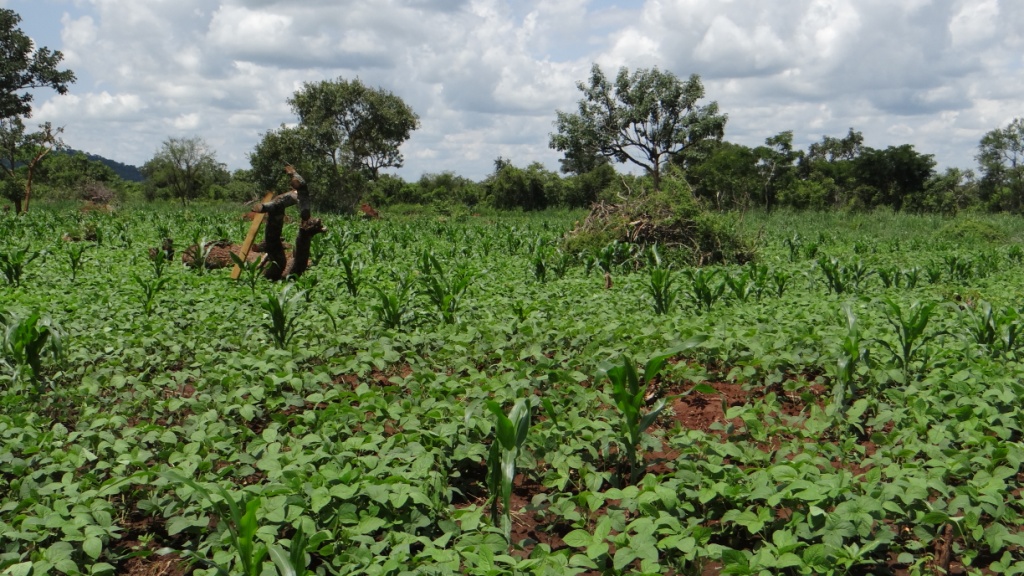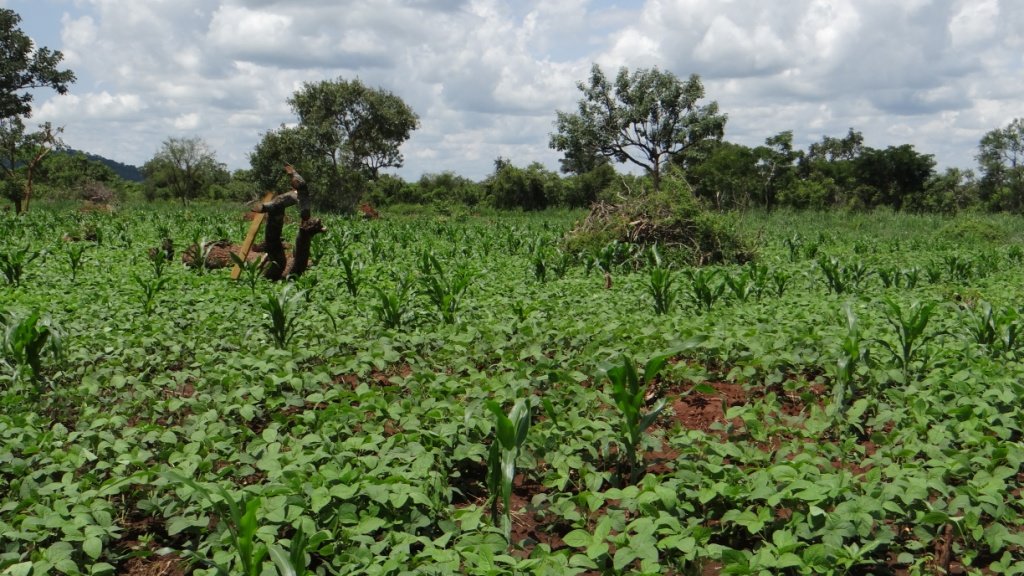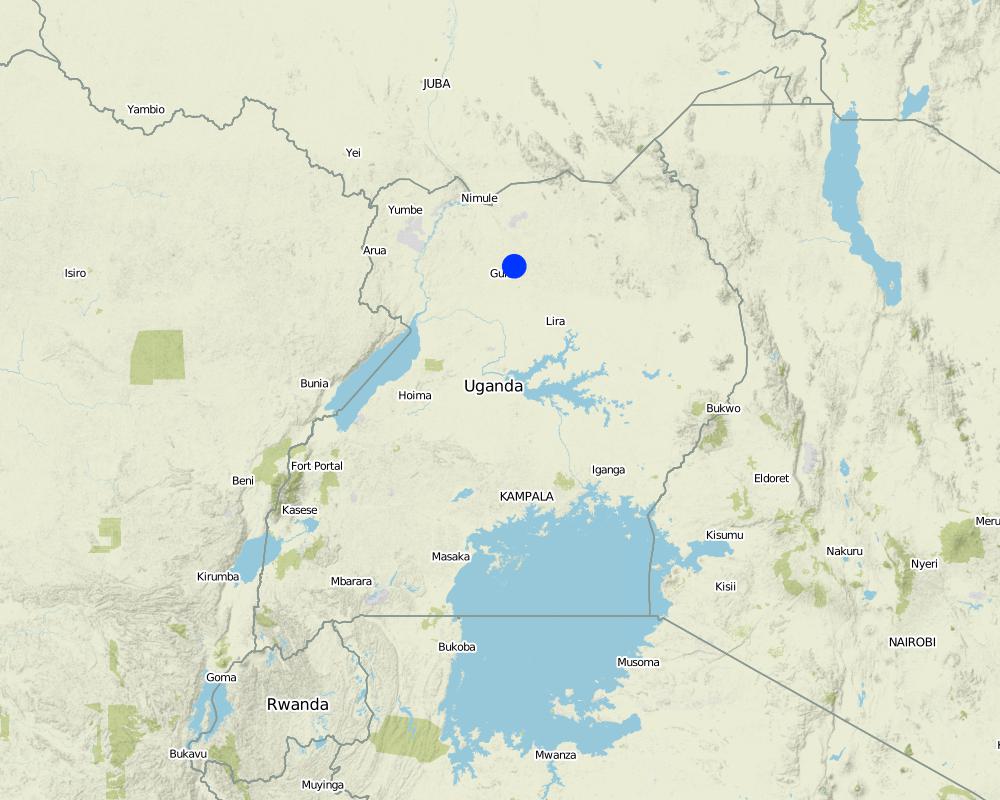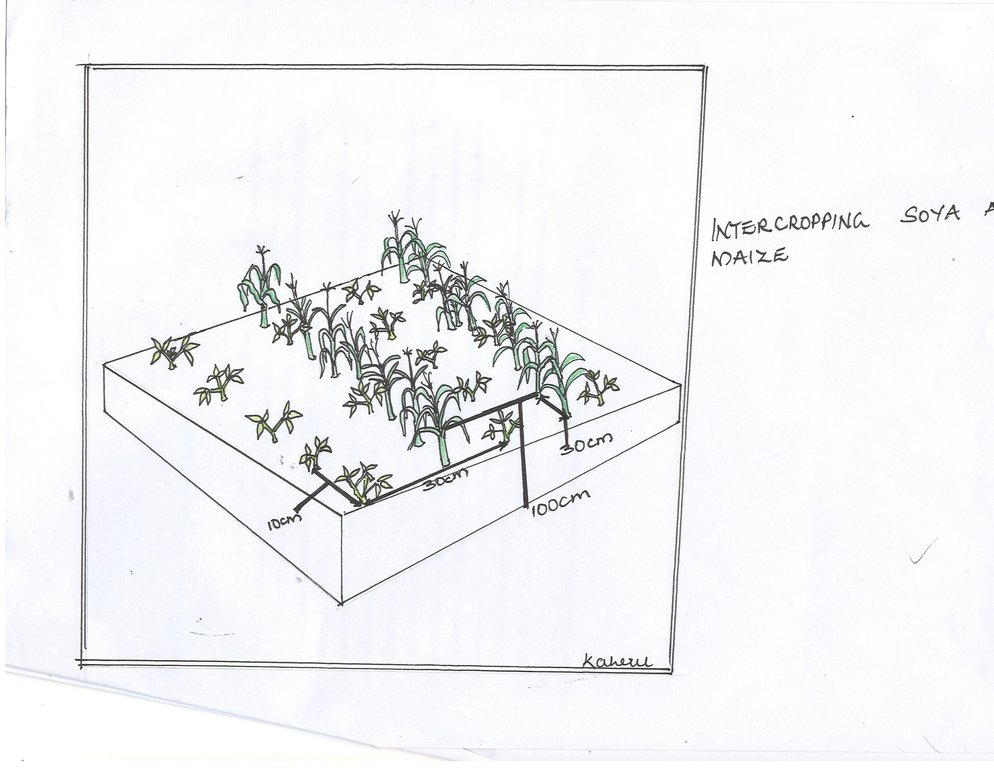Intercropping Soya and Maize [Uganda]
- Creation:
- Update:
- Compiler: Kamugisha Rick Nelson
- Editors: JOY TUKAHIRWA, Richard Otto Kawawa, Sunday Balla Amale, Bernard Fungo
- Reviewers: Donia Mühlematter, John Stephen Tenywa, Nicole Harari, Renate Fleiner, Stephanie Jaquet
Ribo Kodi Aryo
technologies_2815 - Uganda
View sections
Expand all Collapse all1. General information
1.2 Contact details of resource persons and institutions involved in the assessment and documentation of the Technology
Key resource person(s)
land user:
Oloya John
Farmer
Uganda
Name of project which facilitated the documentation/ evaluation of the Technology (if relevant)
Scaling-up SLM practices by smallholder farmers (IFAD)Name of the institution(s) which facilitated the documentation/ evaluation of the Technology (if relevant)
CDE Centre for Development and Environment (CDE Centre for Development and Environment) - Switzerland1.3 Conditions regarding the use of data documented through WOCAT
The compiler and key resource person(s) accept the conditions regarding the use of data documented through WOCAT:
Yes
1.4 Declaration on sustainability of the described Technology
Is the Technology described here problematic with regard to land degradation, so that it cannot be declared a sustainable land management technology?
No
2. Description of the SLM Technology
2.1 Short description of the Technology
Definition of the Technology:
Soybean (Glycine max) and maize (Zea Mays) and planted together in the same field to increase soil fertility, production and household income.
2.2 Detailed description of the Technology
Description:
Inter cropping is a practice where farmers cultivate two different crops in the same field. Usually, a leguminous crop (Soybean) is planted with a non-leguminous crop (Maize). The leguminous crop helps to fix nitrogen in to the soil; produce nitrogen generated from the decomposition of the rich crop residues, and adds nutrient to the soil. This in turn reduces the net demand for fertilizers based on nitrogen. The farmer planted soybean variety Maksoya 3N with a yield potential of 3,500 kg/ha; at a spacing of 10cm × 30cm with 2 seeds per hole and at a seed rate of 20 - 25 kg/acre. Longe 7H Maize variety was then sparsely inter-planted at a spacing of 30cm x 10m with 3 seeds per hole; in between the soybean.
Intercropping Maize and soybean is particularly important because soybean is mainly a cash crop and thus act as a source of income while the maize provides food for the household. If one crop fails, the other may survive hence acts as insurance against crop failure. Planting two crops in a field also reduces the workload associated with cultivating each crop in separate fields. The root systems of the two crops are at different soil layers hence competition for nutrients and water is minimal.
A good intercrop has the main crop and the minor crop. The main crop usually has the recommended seed rate of mono crop while the minor crop may be planted depending on its relative importance and effect on the main crop. However, in intercropping system, the yield potentials of each of the crops is realized.
2.3 Photos of the Technology
2.4 Videos of the Technology
Comments, short description:
Video on inter cropping maize and soya
Date:
26/05/2017
Location:
Patuda Village, Paicho Parish -Paicho Sub-county , Gulu District
Name of videographer:
Issa Aiga
2.5 Country/ region/ locations where the Technology has been applied and which are covered by this assessment
Country:
Uganda
Region/ State/ Province:
Northern Region,Uganda
Further specification of location:
Gulu District
Specify the spread of the Technology:
- applied at specific points/ concentrated on a small area
Map
×2.6 Date of implementation
Indicate year of implementation:
2014
If precise year is not known, indicate approximate date:
- less than 10 years ago (recently)
2.7 Introduction of the Technology
Specify how the Technology was introduced:
- through land users' innovation
3. Classification of the SLM Technology
3.1 Main purpose(s) of the Technology
- improve production
- reduce risk of disasters
- adapt to climate change/ extremes and its impacts
- create beneficial economic impact
3.2 Current land use type(s) where the Technology is applied

Cropland
- Annual cropping
Number of growing seasons per year:
- 2
Specify:
1st rainny season (march - june) and 2nd rainy season (august-Nov)
3.4 Water supply
Water supply for the land on which the Technology is applied:
- rainfed
3.5 SLM group to which the Technology belongs
- improved ground/ vegetation cover
- integrated soil fertility management
3.6 SLM measures comprising the Technology

agronomic measures
- A1: Vegetation/ soil cover
- A2: Organic matter/ soil fertility

management measures
- M3: Layout according to natural and human environment
- M4: Major change in timing of activities
- M5: Control/ change of species composition
3.7 Main types of land degradation addressed by the Technology

chemical soil deterioration
- Cn: fertility decline and reduced organic matter content (not caused by erosion)

physical soil deterioration
- Ps: subsidence of organic soils, settling of soil

biological degradation
- Bc: reduction of vegetation cover
- Bq: quantity/ biomass decline
- Bl: loss of soil life
3.8 Prevention, reduction, or restoration of land degradation
Specify the goal of the Technology with regard to land degradation:
- reduce land degradation
4. Technical specifications, implementation activities, inputs, and costs
4.1 Technical drawing of the Technology
4.2 General information regarding the calculation of inputs and costs
Specify how costs and inputs were calculated:
- per Technology area
Indicate size and area unit:
7 acres
other/ national currency (specify):
UGX
If relevant, indicate exchange rate from USD to local currency (e.g. 1 USD = 79.9 Brazilian Real): 1 USD =:
3400.0
Indicate average wage cost of hired labour per day:
5000 per person per day
4.3 Establishment activities
| Activity | Timing (season) | |
|---|---|---|
| 1. | Land preparation | once in a year (March) |
| 2. | Planting | Once in a year (April) |
| 3. | Weeding | Once in a year (May) |
4.4 Costs and inputs needed for establishment
| Specify input | Unit | Quantity | Costs per Unit | Total costs per input | % of costs borne by land users | |
|---|---|---|---|---|---|---|
| Labour | Labour for planting land | persons | 5.0 | 5000.0 | 25000.0 | 100.0 |
| Labour | labour for applying seed | Persons | 5.0 | 5000.0 | 25000.0 | 100.0 |
| Equipment | Hoe | Pieces | 4.0 | 10000.0 | 40000.0 | 100.0 |
| Equipment | Watering can | Pieces | 4.0 | 100000.0 | 400000.0 | 100.0 |
| Equipment | Slasher | Pieces | 3.0 | 7000.0 | 21000.0 | 100.0 |
| Plant material | Soya bean | kgs | 120.0 | 2500.0 | 300000.0 | 100.0 |
| Plant material | Maize seeds | kgs | 5.0 | 2000.0 | 10000.0 | 100.0 |
| Total costs for establishment of the Technology | 821000.0 | |||||
4.5 Maintenance/ recurrent activities
| Activity | Timing/ frequency | |
|---|---|---|
| 1. | Weeding | Once a season |
| 2. | Harvesting | Once a season |
4.6 Costs and inputs needed for maintenance/ recurrent activities (per year)
| Specify input | Unit | Quantity | Costs per Unit | Total costs per input | % of costs borne by land users | |
|---|---|---|---|---|---|---|
| Labour | labour | Persons | 10.0 | 5000.0 | 50000.0 | 100.0 |
| Total costs for maintenance of the Technology | 50000.0 | |||||
Comments:
Annual crops.
4.7 Most important factors affecting the costs
Describe the most determinate factors affecting the costs:
Labour takes most of the costs.
5. Natural and human environment
5.1 Climate
Annual rainfall
- < 250 mm
- 251-500 mm
- 501-750 mm
- 751-1,000 mm
- 1,001-1,500 mm
- 1,501-2,000 mm
- 2,001-3,000 mm
- 3,001-4,000 mm
- > 4,000 mm
Specify average annual rainfall (if known), in mm:
1200.00
Agro-climatic zone
- sub-humid
5.2 Topography
Slopes on average:
- flat (0-2%)
- gentle (3-5%)
- moderate (6-10%)
- rolling (11-15%)
- hilly (16-30%)
- steep (31-60%)
- very steep (>60%)
Landforms:
- plateau/plains
- ridges
- mountain slopes
- hill slopes
- footslopes
- valley floors
Altitudinal zone:
- 0-100 m a.s.l.
- 101-500 m a.s.l.
- 501-1,000 m a.s.l.
- 1,001-1,500 m a.s.l.
- 1,501-2,000 m a.s.l.
- 2,001-2,500 m a.s.l.
- 2,501-3,000 m a.s.l.
- 3,001-4,000 m a.s.l.
- > 4,000 m a.s.l.
Indicate if the Technology is specifically applied in:
- not relevant
5.3 Soils
Soil depth on average:
- very shallow (0-20 cm)
- shallow (21-50 cm)
- moderately deep (51-80 cm)
- deep (81-120 cm)
- very deep (> 120 cm)
Soil texture (topsoil):
- medium (loamy, silty)
Soil texture (> 20 cm below surface):
- medium (loamy, silty)
Topsoil organic matter:
- medium (1-3%)
5.4 Water availability and quality
Ground water table:
5-50 m
Availability of surface water:
medium
Water quality (untreated):
good drinking water
Is water salinity a problem?
No
Is flooding of the area occurring?
No
5.5 Biodiversity
Species diversity:
- medium
Habitat diversity:
- medium
5.6 Characteristics of land users applying the Technology
Sedentary or nomadic:
- Sedentary
Market orientation of production system:
- mixed (subsistence/ commercial)
Off-farm income:
- less than 10% of all income
Relative level of wealth:
- average
Individuals or groups:
- individual/ household
Level of mechanization:
- manual work
- animal traction
Gender:
- women
- men
Age of land users:
- youth
- middle-aged
Indicate other relevant characteristics of the land users:
The land user is also a carpenter where he earns some additional income to support his technology (buying seed, paying for labour and equipment).
5.7 Average area of land used by land users applying the Technology
- < 0.5 ha
- 0.5-1 ha
- 1-2 ha
- 2-5 ha
- 5-15 ha
- 15-50 ha
- 50-100 ha
- 100-500 ha
- 500-1,000 ha
- 1,000-10,000 ha
- > 10,000 ha
Is this considered small-, medium- or large-scale (referring to local context)?
- medium-scale
Comments:
Utilizes small area for cultivation.
5.8 Land ownership, land use rights, and water use rights
Land ownership:
- individual, not titled
Land use rights:
- individual
Water use rights:
- communal (organized)
5.9 Access to services and infrastructure
health:
- poor
- moderate
- good
education:
- poor
- moderate
- good
technical assistance:
- poor
- moderate
- good
employment (e.g. off-farm):
- poor
- moderate
- good
markets:
- poor
- moderate
- good
energy:
- poor
- moderate
- good
roads and transport:
- poor
- moderate
- good
drinking water and sanitation:
- poor
- moderate
- good
financial services:
- poor
- moderate
- good
6. Impacts and concluding statements
6.1 On-site impacts the Technology has shown
Socio-economic impacts
Production
crop production
Quantity before SLM:
0.5 bag
Quantity after SLM:
3 bags
Comments/ specify:
Increased yield from soya and maize compared to before the technology.
crop quality
Comments/ specify:
Crops grow vigorously, good pod filling.
risk of production failure
Comments/ specify:
In case of one crop failure the other crop the other crop survives.
product diversity
Quantity before SLM:
1 crop
Quantity after SLM:
2 crops
Comments/ specify:
More than one crop in the field.
production area
Comments/ specify:
Due to intercropping.
Income and costs
expenses on agricultural inputs
Comments/ specify:
especially on seeds and labour
Socio-cultural impacts
food security/ self-sufficiency
Ecological impacts
Soil
soil cover
Comments/ specify:
Maize stalks and soya wastes are left in the garden to provide mulch after decomposition.
nutrient cycling/ recharge
Comments/ specify:
The leguminous crop helps to fix nitrogen into the soil; produce nitrogen generated from the decomposition of the rich crop residues, and adds nutrient to the soil.
6.3 Exposure and sensitivity of the Technology to gradual climate change and climate-related extremes/ disasters (as perceived by land users)
Climate-related extremes (disasters)
Meteorological disasters
| How does the Technology cope with it? | |
|---|---|
| local hailstorm | moderately |
6.4 Cost-benefit analysis
How do the benefits compare with the establishment costs (from land users’ perspective)?
Short-term returns:
slightly negative
Long-term returns:
slightly negative
How do the benefits compare with the maintenance/ recurrent costs (from land users' perspective)?
Short-term returns:
positive
Long-term returns:
positive
6.5 Adoption of the Technology
- 11-50%
Of all those who have adopted the Technology, how many did so spontaneously, i.e. without receiving any material incentives/ payments?
- 11-50%
Comments:
The land user started on their own after learning from other land users. The knowledge acquired from the land users was enough to make start on their own.
6.6 Adaptation
Has the Technology been modified recently to adapt to changing conditions?
No
6.7 Strengths/ advantages/ opportunities of the Technology
| Strengths/ advantages/ opportunities in the land user’s view |
|---|
| An assurance against crop failure - when one crop fails the other one steps in for food security and income. |
| Act as both a food and a cash crop. |
| Strengths/ advantages/ opportunities in the compiler’s or other key resource person’s view |
|---|
| The technology saves time for other activities in a year. |
| Can be replicated else where by other small scale and large scale farmers with similar or different pieces of land. |
6.8 Weaknesses/ disadvantages/ risks of the Technology and ways of overcoming them
| Weaknesses/ disadvantages/ risks in the land user’s view | How can they be overcome? |
|---|---|
| Competition for nutrients among crops and yield may not be like in mono culture. | Ensuring proper crop combination per inter crop. |
| Congestion among crops if the spacing is not done well | Ensuring proper spacing between crops. |
| Weaknesses/ disadvantages/ risks in the compiler’s or other key resource person’s view | How can they be overcome? |
|---|---|
| If the land user depends on inter cropping annual crops on may not be paying in the short run. |
Promote inter cropping with perennial crops like bananas for mulching using bananas. Diversification (Livestock and other crops like beans and banana). |
| The way the inter crop looks now is not a good enough as the land user needs advice from the extension worker on how to do inter cropping with the right spacings and the appropriate used crops. | A good intercrop skills should be provided such as including cover crops like beans and Mucuna Spp. |
7. References and links
7.1 Methods/ sources of information
- field visits, field surveys
01
- interviews with land users
01
When were the data compiled (in the field)?
25/05/2017
Links and modules
Expand all Collapse allLinks
No links
Modules
No modules







